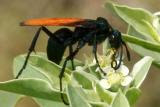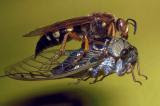 Tarantula hawk wasp, found commonly across New Mexico, is the New Mexico state insect. (Courtesy photo by Whitney Cranshaw, Colorado State University, Bugwood.com)Rest easy: The large wasp dubbed a “murder hornet” by the media is not murderous to humans. Nor is it found in New Mexico, according to New Mexico State University Cooperative Extension Service specialists.
Tarantula hawk wasp, found commonly across New Mexico, is the New Mexico state insect. (Courtesy photo by Whitney Cranshaw, Colorado State University, Bugwood.com)Rest easy: The large wasp dubbed a “murder hornet” by the media is not murderous to humans. Nor is it found in New Mexico, according to New Mexico State University Cooperative Extension Service specialists.
In July, Extension offices and New Mexico Department of Agriculture received a plethora of calls from concerned citizens regarding sightings of large wasps.
“The Bernalillo County Extension office received over a hundred calls in one week,” said John Garlisch, agricultural agent at NMSU’s Extension office in Albuquerque. “From the pictures and samples observed, everything we saw was identified as the ‘cicada killer’ wasp or the tarantula hawk wasp. Both are commonly found in New Mexico.”
 Cicada killer wasp, found commonly across New Mexico, carrying a paralyzed cicada back to its nest. (Courtesy photo by Ronald F Billings, Texas A&M Forest Service, Bugwood.org)NMSU College of Agricultural, Consumer, and Environmental Sciences has a new publication to help people identify the difference between Asian giant hornets and other large wasps commonly found in New Mexico and the Southwest.
Cicada killer wasp, found commonly across New Mexico, carrying a paralyzed cicada back to its nest. (Courtesy photo by Ronald F Billings, Texas A&M Forest Service, Bugwood.org)NMSU College of Agricultural, Consumer, and Environmental Sciences has a new publication to help people identify the difference between Asian giant hornets and other large wasps commonly found in New Mexico and the Southwest.
“Although the name ‘murder hornet’ was given to these wasps, they are more commonly known by their less intimidating common name of Asian giant hornet,” said Amanda Skidmore, NMSU Extension integrated pest management specialist.
“While the media was abuzz with this introduced species into the United States, none have been found in the Southwest, and only a few have been found in the northwestern United States in Washington, along the Canadian border in 2019,” Skidmore said. “The Asian giant hornet should not pose an immediate threat to New Mexico because it prefers temperate rain forests and not high desert climates or high elevations.”
The cicada killer wasp has a similar body type and color to the Asian giant hornet, which may confuse observers.
“The Asian giant hornet has a distinctive yellow-orange head and body with coarse hairs, along with the black and yellow-orange stripes on its body,” Skidmore said. “It is about 2.5 inches long, with a wingspan up to 3 inches.”
The hornets are extremely aggressive toward honey bees and other insects, thus its media name murder hornet.
“A few hornets can destroy a hive quickly by decapitating honey bees and taking over the hive for their own uses,” Skidmore said. “Domestic honey bees in North America have not evolved to effectively defend their hives, but honey bees in Asia have evolved defensive strategies to protect their hives from the Asian giant hornets.”
Normally, these hornets are not aggressive toward humans unless actively provoked.
“People with severe allergies to insect bites and stings should take normal precautions when interacting with nature, including packing antihistamines when hiking, camping or gardening,” Skidmore said.
The NMSU Extension publication includes information and photos to help observers identify the cicada killer wasp and tarantula hawk wasp, which is the New Mexico state insect.
To obtain a copy of the publication, visit https://aces.nmsu.edu/pubs/_h/H175.pdf